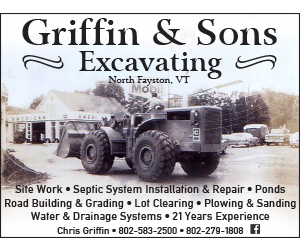Ethan and Virginia Hume expressed concerns about the proposed developments' proximity to their lot line and the potential for wastewater runoff on their property, as well as their understanding from the previous owner, Al Rosetto, that they had rights to a backup spring that passes through Kolitch's property, although located on property owned by a third party.
"There is a lot of water on that property," Virginia Hume told the commission.
Kolitch produced a letter from Atty. Sheila Ware stating that, after a thorough title search, she could find no reference to any such written documentation of these rights, and suggested that she may have the pipe disconnected as a way of ending the problem. The Hume's plan to ask their attorney, Sheila Getzinger, to also do a title search to verify whether they have any formal rights to the spring. Engineer Gunner McCain stated that the pipe should be disconnected as a potential site of contamination from an existing waste treatment site above that has been in place over seven years.
Neighbor Todd Drummey, who also had reservations about the safety of his water system, seemed content with the explanation by McCain that his spring is well outside the 500-foot area of building. Commissioners were concerned about the location of the building in what appears to be a very wet area and the potential for runoff.
Commissioners Shayne Jaquith and Margaret Torizzo expressed concerns about the results of wetlands consultant Errol Briggs' findings that this was a Class 3 wetland, particularly following the testimony heard earlier from Alan Quackenbush.
When Torizzo asked Kolitch if she would consider having a state wetlands coordinator visit the site and make a decision, her answer was an adamant, "No, I do not want a state biologist mucking around on my property."
She agreed to hiring another consultant if the town had any concerns about Mr. Briggs' credentials but stated that she would want input into any decision to get a second opinion, as suggested by Jaquith. Torizzo stated that her question was to get "an unbiased opinion."
After considerable back and forth questioning and no ability to find a middle ground, the commissioners voted to continue the hearing on September 5 at 9 p.m., after Kolitch has had time to have Briggs provide his justifications for his wetlands classification, allowing time for the Hume's to have an intensive title search done to verify that they have no legal rights to the spring, and for the commission to explore the credentials of the consultant, or provide names of other private consultants that they do approve, from which Kolitch could choose.
Prior to that hearing, Alan Quackenbush, Vermont state wetlands coordinator, provided a brief explanation of the present state wetland regulations which are currently undergoing a revision as mandated by the legislature in a Permit Reform Bill last session. With the abolition of the State Water Resources Board which used to reclassify areas, new rules must be promulgated to define wetland classifications and functional values which now will be heard in the new Environmental Court.
All decisions will now be based on these new rules rather than court decisions, according to Quackenbush, who further stated that it is very difficult to determine the differences between Class 2 and Class 3 designations. Often, the only difference between Class 2 and Class 3 wetlands is whether they have been mapped or not, and softwood forest canopies often make it quite difficult to identify from aerial photos.
Under current state regulations, Class 2 wetlands are designated as having significant impact, while class 3 wetlands do not. However, Quackenbush explained that these designations are often quite arbitrary, dependent upon the wetland consultants' scientific opinions, which may vary considerably, one from another, and which "have no established process for applying the rules."
When asked about certification and specific standards set for ANR's list of acceptable wetlands' consultants, Quackenbush answered that currently there is no federal or state certification process and no uniform standards used to qualify wetlands consultants. New rules are now being revised for next year's legislature to review. He further stated that the town and other federal or state entities may also designate significant functional impacts, regardless of the size of the wetland or whether it is manmade or not, and that a few Vermont towns, including Warren, now regulate their own wetlands.
Federal regulations have stated that there are over 800,000 Class 1 and 2 wetland areas in Vermont, while the state has only identified 232,000 acres, he stated. Quackenbush closed by stating that he would be glad to arrange a training session for the commissioners, if desired, probably with the designated coordinator for this part of the state, Shannon Morrison. The Town of Fayston is currently undertaking a natural resources inventory as part of the revision of the town plan, and Quackenbush indicated that wetlands designations could easily be rolled into this process.
In other business, Carlton Fuller, PE, presented for the Don Simonini preliminary hearing for a three-lot subdivision off Deer Run Road, below the Carrie Strong Road, off Center Fayston Road. The Commission voted that this would be considered a minor subdivision requiring only one public hearing which was scheduled for August 15 at 7 p.m.
{loadnavigation}





